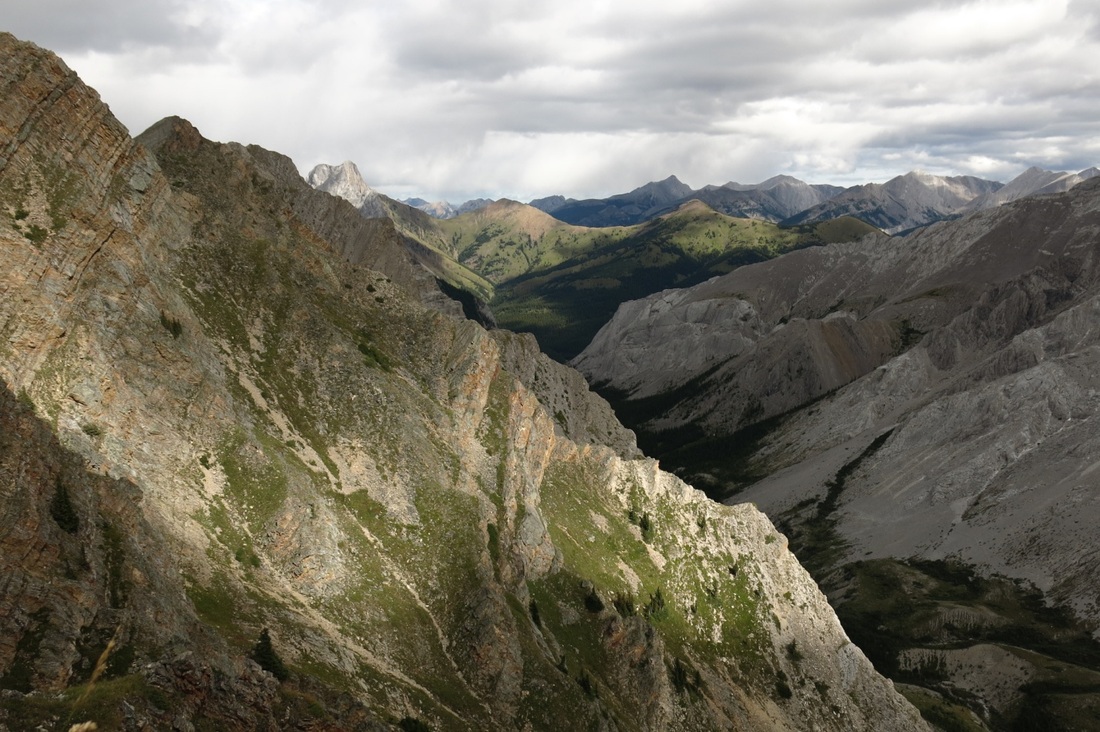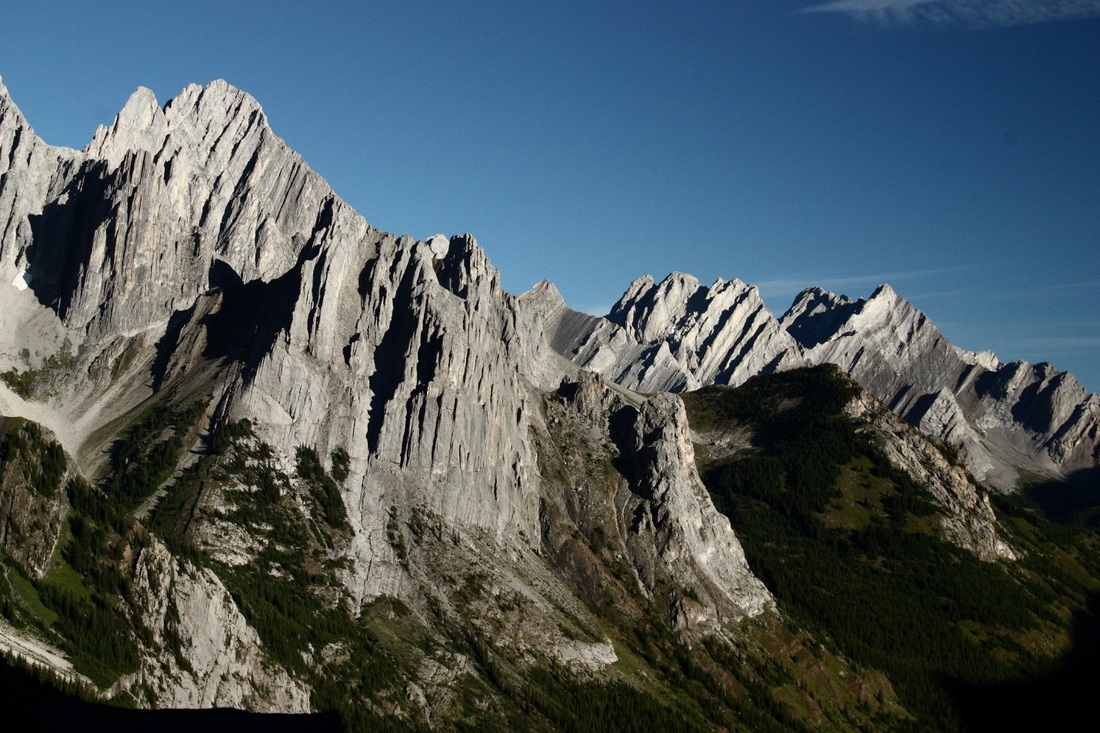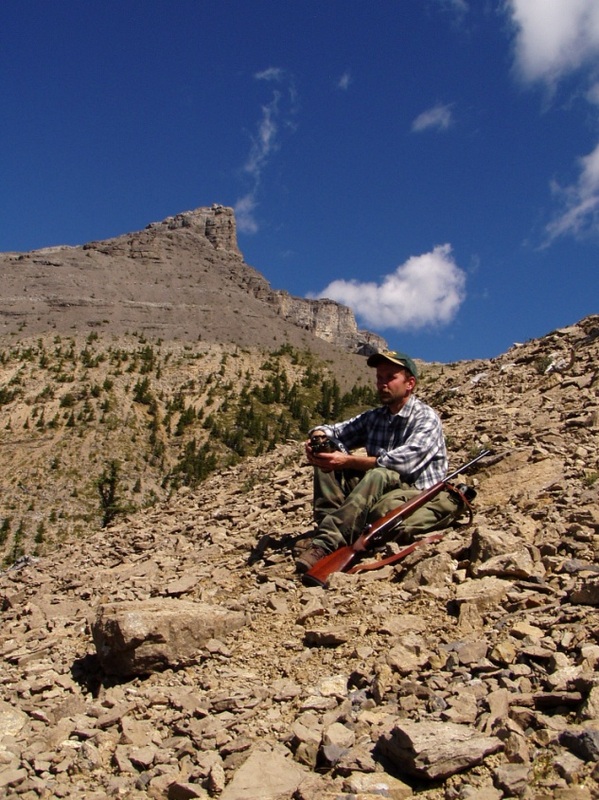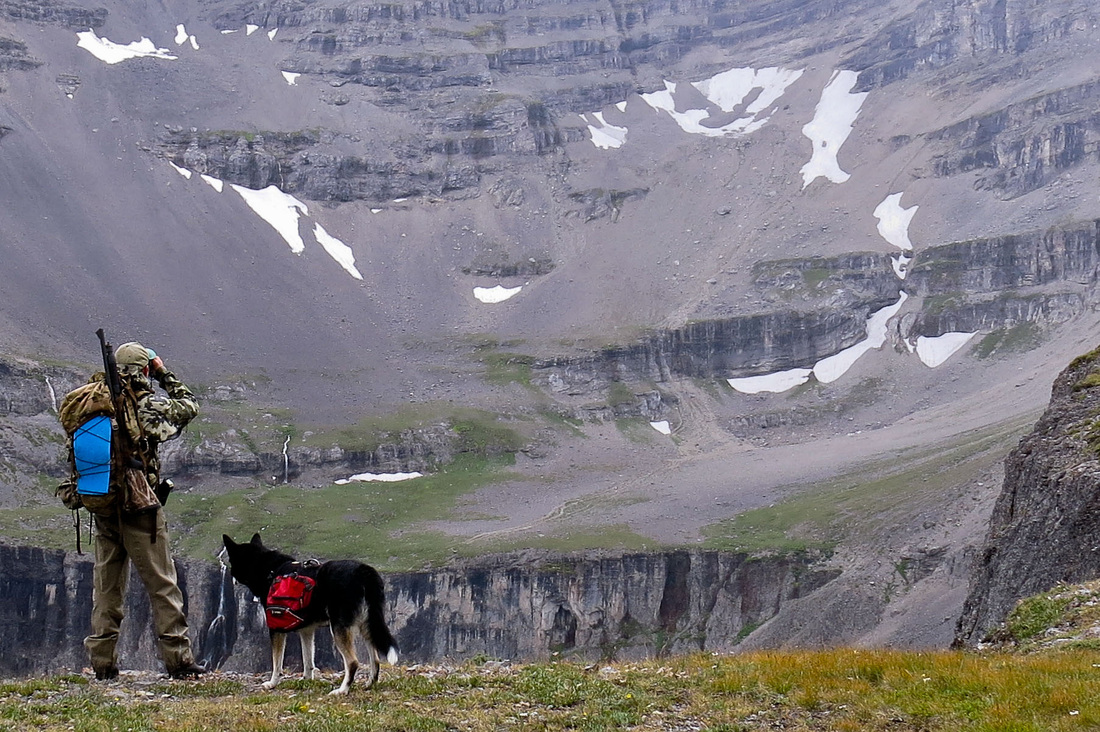This story was written a few years after my first two seasons of sheep hunting. It reflects the knowledge and experience I had at the time. I don’t adhere anymore to everything that I wrote back then. I grew up, got wiser, gained experienced, changed gear, and generally became a better mountain hunter. For all the savvy I acquired, I wish I still had the unbridled energy I had back then.
I lost most of my photos from that time, so some of them are retakes from when I visited the same valleys in later years, and others are scanned from prints, with the obvious reduction in image quality.
The ram had chosen his spot well. From his high-perched throne the king of the mountain had a commanding view of his empire. He could see well down the valley, spotting the movement of any two or four-legged predator, long before they’d be able to see him. He oversaw the low lying mountain meadows, where the ewes and lambs and lesser rams grazed. He glanced at the eagles as they soared high above, raising his magnificent head to show off his mighty horns. The jagged rocks of the knife-edge ridge hid him from sight from anything that managed to reach the same altitude. And in his back, one of the nastiest climbs you’d ever want to tackle without rock climbing gear.
I watched the ram from across the valley. In the predawn I had made my way up the eastern ridge of a no-name creek, to be able to glass the lush green alpine meadows I knew attracted animals of all sorts to this drainage. Grizzlies dug for marmots on these slopes, tearing large chunks from the brown rocky soil with their powerful claws. Sheep and elk shared the grazing rights, and occasionally a mountain goat could be seen high up in the rocks. Ptarmigan scurried along the trails, and little pikas yelled their alarm calls from the rock slides. Well-hidden between a few boulders I glassed the opposite ridges and the slopes below. It has taken me a while to learn how to glass, and at times I still can’t garner the patience it takes to meticulously search a mountain side for sheep. But this day it felt good to hide from the icy wind. The rising sun behind me illuminated the little hideaways that would just be dark shades later in the day. Down below little bands of ewes and lambs nibbled from the grass. They didn’t interest me. It was too early for the rut, which in Alberta falls largely outside of hunting season. I glassed higher, looking for a ram.
 It took me about an hour and half to find him, much higher than I had anticipated. He was bedded down almost on top of the ridge. It was much too far off to judge his horns in detail, but he seemed legal. I watched him for a while longer through the spotting scope, while I mentally started to map out the approach. The closest spot where I could cross the valley without being seen was about a mile to the north. I would have to climb back down to get out of sight, traverse to the north, climb over the ridge and down into the timber at the valley bottom. From there up the other side, across the ridge, and then somehow make my way up to the ram from behind. A four hour endeavour at least. I glassed around some more, and looked at the ram again and again. It was hard to tear myself away from the magnificent sight, and my comfortable hide-out. The next few hours would be hard work.
It took me about an hour and half to find him, much higher than I had anticipated. He was bedded down almost on top of the ridge. It was much too far off to judge his horns in detail, but he seemed legal. I watched him for a while longer through the spotting scope, while I mentally started to map out the approach. The closest spot where I could cross the valley without being seen was about a mile to the north. I would have to climb back down to get out of sight, traverse to the north, climb over the ridge and down into the timber at the valley bottom. From there up the other side, across the ridge, and then somehow make my way up to the ram from behind. A four hour endeavour at least. I glassed around some more, and looked at the ram again and again. It was hard to tear myself away from the magnificent sight, and my comfortable hide-out. The next few hours would be hard work.
The first part of the stalk was uneventful. It didn’t get really tiring until I started up the other side of the valley. The climb was steep, but the footing was good, so I made good time. The surprise came when I peeked over the ridge. My hope of dropping down a few hundred yards, and traversing to the South to end up below the ram was shattered. The enormous forces that created these mountains eons ago had shaped a landscape that was unbelievable. Somehow the horizontal sheets of rock had been turned ninety degrees upwards. Slightly slanted to the south, gigantic rock layers reached into the sky. In between the rocky pinnacles, erosion had deposited a thick carpet of shale. It was impossible to proceed along the ridge, as the sheer drops were dozens and dozens of feet. There was no way to traverse, as the rock layers jutted out of the mountain, and allowed no way around them. I needed to climb down to where the mountain face changed back into horizontal, traverse to the south, and try to pick the right way up from there. This would add at least two hours to the stalk. I tried to picture in my mind the slopes below the ram, and searched for a way to approach from that side. But his strategic position and the presence of more game on the lower slopes would make that impossible.

The higher I climbed the finer and less stable the shale became. Sheep trails crossed and disappeared into the rocks. By now I was working my way up by staying close to solid rock. With one hand I held on to the rock, and with the other I wielded my 6-foot hazel walking stick to maintain my balance. Whenever I thought I was approaching the ridge, another series of jagged semi-pinnacles appeared. A small band of ewes and lambs traversed above me. They didn’t notice me. I found a fossil, demonstrating that, incredible as it may seem, this was once sea bottom. I put it in my pocket. Slowly I reached what really looked like the last stretch: a semi-chimney, with a bottom of the finest gravel you can imagine. Right through the middle a well-worn sheep trail showed the way. I looked down, and almost felt a surge of nausea. No matter what, I was not going back down that way!
This was the scariest bit of climbing I had ever done. It was like walking on the beach, only then under a 45 degree angle. Every step felt like it would be the last before the whole slope would give way and take me down in an avalanche of rocks. It was only 100 feet or so, but it took a lifetime. The relief of finally regaining solid footing was overwhelming. With shaking knees I settled down against a rock, emptied a bottle of water, and tried to eat some sausage. In the valley bottom the ewes were still grazing.
I looked around. Somewhere here the ram had his bed. Slowly I cycled a cartridge into the chamber. The wind was blowing from the north, so I needed to search in that direction, hoping that I’d gone south far enough to get beyond the ram. I stepped around the rock, and almost stepped into a big shallow depression in the shale. In disbelief I stared at the empty bedding spot. I dropped my pack in the shallow depression, scraped out by the hooves of a bighorn ram, and sat down beside it. A big rock blocked the arctic winds from the rear, the warming rays of sun felt comforting on my face. In front of me, across the valley, I saw the ridge from where I first spotted the ram, six hours ago. What a location! Any animal lying here would be invisible from a horizontal view, unapproachable without a noise from behind, and anything coming up from the front would be spotted long before it even got close. It seemed that by some stroke of coincidence, I climbed up exactly to where the ram had bedded down. He might have left his bed hours ago, or just seconds ago, when he heard me climb up from behind. The result was the same.
I hunted around the saw-tooth ridge for another hour, but found neither ram, nor other beds. A juvenile mountain goat looked at me from a hundred feet away for over a minute, before disappearing over the edge. I checked where it disappeared, it was sheer vertical nastiness. If I hadn’t seen the goat go there I would never have believed it was possible.
Though unsuccessful in terms of killing, I consider this the best day of sheep hunting I have ever experienced. It held everything but the final act. Spotting the animal early, planning and executing the stalk, some hair-raising climbing, beautiful country, new vistas, and decent weather; what more can a sheep hunter ask for?

Bighorn sheep wander all the way from the park boundaries to the foothills, and can be found in many of the major drainages. Unfortunately, they are never present in the all drainages at the same time. Unless you are lucky, you need to look long and hard before you find a ram. During the majority of the hunting season, which runs from early September to the end of October, rams tends to bunch up in bachelor groups. A friend of mine, and my sheep hunting guru, has counted over 25 rams in a band on more than one occasion in this unit. When you combine this with the relatively low population density of sheep in general, it becomes apparent just how many square miles can be devoid of sheep, let alone legal rams.
I was not to be deterred however by statistics. I was drawn by a long drainage, close to a well-known sheep wintering area. Access was by river crossing, or by a very long, arduous two-day hike and according to the map, about three miles into this drainage a side valley lead to two high basins, one of which held two small lakes. The map even showed some green, which led me to believe there might be some prime grazing up there. Water, food, and refuge; this is what I read about. There had to be sheep up there. So, after spending an afternoon finding the right spot to cross – turns out the map was old enough to not show a new road extension and parking lot – I found myself staring at the raging waters, and the 40-foot stretch that separated me from the trailhead.
These days I take a pair of surf shoes with me to prevent foot injury, but of course I hadn’t then. Barefooted and in my undies I started to wade across. The current was strong, and the river deeper than I thought. The water pulled my leg away every time I lifted it to make the next step. Slowly I got pushed downstream, to where a joining creek made the water look even more menacing. The ice-cold water now came to my waist. The way back looked just as unappealing as going forward. Rapidly my feet were turning numb. I just lunged forward, somehow managing not to become completely submerged. Wet and shivering cold I climbed up the other bank. It was a good thing that the creek after which the drainage was named was much shallower. Finally, I was on my way to the sheep! Navigating was easy, I just followed the creek until I hit the side stream, and up from there. I got side tracked a bit by following game trails which went up on a more gradual course, and this contributed to some serious discomfort later on in the day. It quickly turned out that I wasn’t as sheep-fit as I had imagined. The climb gradually became steeper. When the trees grew shorter and finally completely vanished, the footing became treacherous and slippery. Sweat poured down my body like never before. The sun appeared and added to my agony. My water supply dwindled quickly. But I wasn’t worried since the map showed two small creeks, and of course the little lakes.
Finally I reached the ridge, and I could start thinking about glassing and hunting. I found a few beds at the very top of a sort of amphitheatre. Sheep had been there, they just weren’t home at the right time. I hiked along the ridge and glassed around from time to time. I had a wonderful view of the eastern most basin, and below me was the biggest shale field I’d ever seen, and have seen since. The size of the country, and everything in it was beginning to impress me. The logistics of getting a sheep out of there started to weigh heavy on my mind. The rising temperature and constantly shifting footing were quickly draining my strength. Though a far ridge was beckoning, I decided to start heading back, by way of the second basin, where I could replenish my water supply. Down at the bottom of the shale field, grey rock towered overhead, and the coloured sediment layers made the ridge look even more impressive! This was big country, and I was just a mere speck in the landscape.

A second creek bed ran straight down from where I was, and I decided to follow it instead of making my way back along the route that I came up on. This was another mistake. Quickly the easy terrain turned nasty. I had a choice, either to fight my way through thick tanglewood, or to stay in the creek bed and face huge boulders, slippery rock, and big drop-offs. By now my feet were telling me that enough was enough, and blisters started to appear. Feeling absolutely miserable I continued, until a 150-foot cliff blocked my path. Somehow I found a way around, and exhausted and dehydrated I finally reached the creek. I sank to my knees in the water and drank and drank, and poured the cool liquid over my pounding head. My agonizing thirst and borderline dehydration somewhat mitigated, I examined my feet, which by now were bleeding in several places. Before me lay a 4-mile hike back to the initial river crossing, but at least I had water.
Back at the river I didn’t bother taking off shoes or clothing. Frankly I was too tired. I waded straight through, which attracted weird looks from a family that was having a shore picnic. I’ve never been so glad to be able to sit down on a cushioned seat.
Disillusioned I drove home. These mountains required more toughness and fitness than I could bring to bear. The next day I stayed home, and the day after I only hiked a few horizontal miles, glassing the slopes from below. I gladly accepted the local notion that you either shoot your ram in the first few days of the season, when the sheep haven’t wizened up yet, or in the last few days, when early rutting jitters or bad weather brings the sheep down out of the parks. It was a poor excuse, but I just couldn’t cut it. An invitation to come south to Montana, to help out in a deer and antelope hunt came at the end of October, and saved me from more humiliation.

Behind my house is a little hill, actually the end of a ridge, which is about 500 feet higher than my backyard. That ridge became my winter training ground. Regardless of temperature or snow cover, I climbed that ridge four or five times a week, sometimes twice or even three times in a row, as the first signs of spring emerged. Purple crocus burst through the snow, and I increased my hill climbing intensity to three or four climbs/descents in a row. When the snow was off the mountains I was able to climb that hill five times in a row. I added cycling to my training regime, until July came around. It was time to hit the mountains…
Continued in Sheep Fever Part 2.

